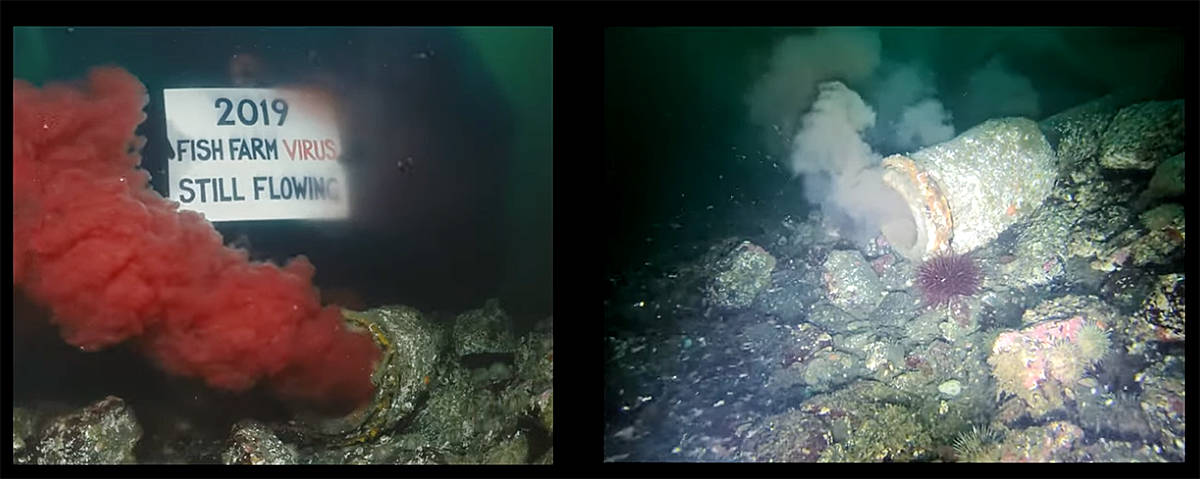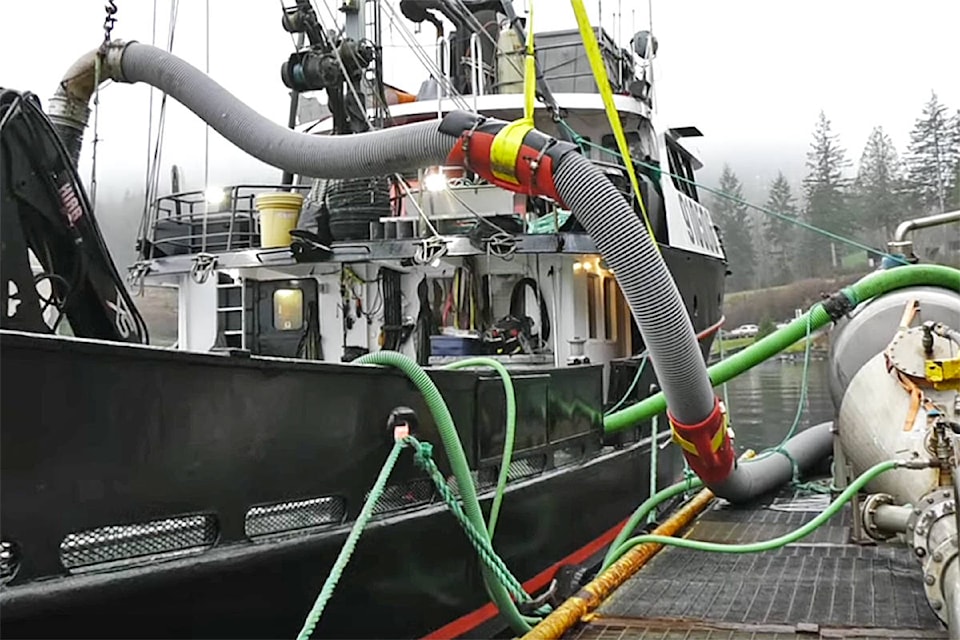An environmentalist’s so-called blood water video released last month doesn’t reflect current conditions around a Campbell River-area fish packing plant’s effluent, the plant’s manager says.
And to counter the “misinformation” spread by Tavish Campbell’s video showing bright blood-red effluent spewing from Brown’s Bay Packing Ltd.’s outfall pipe, the company has released its own video showing a much more benign outflow from the plant without the bright red effluent that horrified so many people.
“In recent days, some media reported claims from salmon farming critics that Brown’s Bay Packing continues to produce wastewater that is bloody and red and that nothing has been done since the issue first came to light two years ago in 2017. These reports are simply just not true and they’re misleading,” Brown’s Bay Managing Partner Dave Stover says in the video entitled “This is Now.”
Quite apart from doing nothing, Stover says, the company has invested $1.5 million in building a new wastewater plant from the ground up. Brown’s Bay Packing Ltd. worked with new technology to “push the envelope” and meet or exceed new regulatory standards set by the B.C. Ministry of Environment. Those standards arose out of a first video released by Campbell in 2017 showing “blood water” being discharged by the Brown’s Bay Packing plant.
RELATED: ‘Blood water’ video shows bloody effluent emitting from farmed salmon processing plant
The video was entitled “Blood Water: B.C.’s Dirty Salmon Farming Secret” and included dramatic underwater video of blood-red water being discharged from an underwater pipe into Brown’s Bay north of Campbell River coming from the Brown’s Bay Packing Co. plant. The film also included Lions Gate Fisheries’ plant in Tofino.
The effluent the video shows was tested and said to contain PRV, a virus claimed to be harmful to wild salmon but which the salmon farming industry and Fisheries and Oceans Canada says is naturally occurring and is not harmful to wild salmon. That 2017 video resulted in a provincial Ministry of Environment review in 2018 that determined most fish processing plants that discharge waste into B.C. waters violate provincial regulations and tougher regulations are needed to protect wild salmon from disease-causing pathogens.
At the time, Campbell said that the plant was not doing anything illegal but the video was intended to provoke the province and industry into cleaning up its act.
Campbell went back to Brown’s Bay at the end of October and November of this year, shot more video and pictures of the same effluent pipe and collected more samples. He sent those samples to a lab at the Atlantic Veterinary College in Charlottetown, P.E.I. and he said they came back positive for PRV. He released a new video and a statement Dec. 3 entitled “Two Years Later: Virus-Infected Fish Farm Blood Still Flowing.” Both of Campbell’s videos are dramatic and disgusted many viewers.
RELATED: Blood Water II: Fish processing plant still discharges contaminated effluent, activist says
But Stover questions just when that second video was recorded because that’s not what the effluent coming out of the pipe looks like right now. He told the Campbell River Mirror that he thought blood-red effluent hadn’t been coming out since May of this year. The Mirror has reached out to Campbell for his response to that.
Campbell’s first video released in 2017 had a positive effect, Stover acknowledged. It prompted regulators to get involved and clarify expectations and give industry some clear parameters. It also spurred Brown’s Bay to pursue its own solutions to the problem.
“Tavish’s 2017 video sparked the discussion and I think created the motivation for all stakeholders to make change,” Stover said.
The permitting structure prior to the 2017 video was undeveloped, Stover said, and industry standards needed to be set because what standards they had were very low. The result is a clear permit process and standards to be met.
“We have a new permit. It’s 31 pages long. Our previous one was one (page),” Stover said. “The standards are the strictest on the coast for fish processors.
“In our (fish processing) sector, our plant has the strictest standards.”
And once the company had a clear idea of the standards, it could go out and design and buy equipment.
“It is very difficult to create a treatment plant to achieve a standard that doesn’t exist,” Stover said.
And there’s no equipment “off the shelf” that you can buy to treat blood water. The company had to take the best achievable technology and then figure out how to improve on it. The company received federal and provincial funding for the innnovation it presented and has now essentially completed it, although there’s still a few months of work left to “dial in” the operation.
Stover emphasizes that the video is intended to demonstrate what has been done and what the result is under the water. The video says that all wastewater from the plant is a combination of wash-down water from processing, blood water from harvesting and rain water. All liquid is captured, regardless of its source and transferred to its water treatment system. Blood water from harvest accounts for 15-18 per cent of all liquid sent to treatment. After four stages of the system, all micro-proteins and blood are removed and the effluent is disinfected.
At the point of discharge, what remains is a liquid that is a cloudy-grey-yellow colour, the video shows, and it “resembles lemonade. Not pink lemonade or red but slightly yellow.” At this point the treated effluent enters the outfall pipe.
As it exits at 26 metres deep, the effluent looks grey and the video shows a split screen image of Campbell’s most recent video of blood-red outflow and Brown’s Bay’s video of grey outflow as it currently is.
Stover says in the Brown’s Bay video that what is shown in Campbell’s video is “misrepresented as current.” Campbell said he shot his video at the end of October and November of this year. Stover says in the Brown’s Bay video that the outflow being shown is from “today, straight up with no fancy filters or editing.”
The Brown’s Bay Packing video – mimicking Campbell’s videos – shows a diver floating by the outfall with a sign saying “DEC. 6/19 THIS IS NOW” and the video was published on YouTube on Dec. 12.
Stover said the company wants to set the record straight and welcomes the public to come out and tour the plant.
“The only way to manage public trust is just to open the doors and have people come and look,” Stover said.
@AlstrT
editor@campbellrivermirror.com
Like us on Facebook and follow us on Twitter

